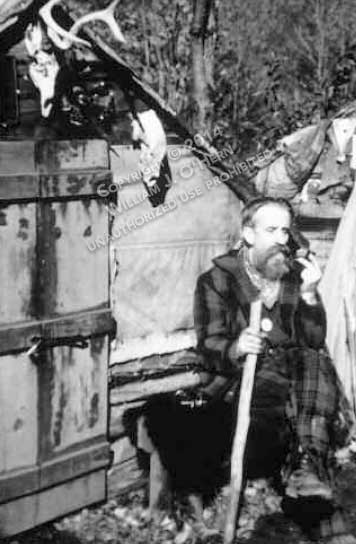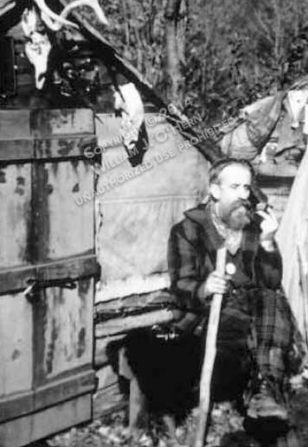Harvey Carr took on the arduous job of moving the [hermit’s] cabin to the [Adirondack] museum. He painstakingly numbered each log, each board, and each item, carefully dismantled it all …

The Hermit and Us – Our Adirondack Adventures with Noah John Rondeau
The Hermit’s cabin moves
An excerpt from “The Hermit and Us”, Starting on page 220
“Harvey Carr was another Blue Mountain Laker. He worked as a logger for a spool company. His company had either bought land in the Cold River country or the timber rights, I don’t remember. I don’t think Harvey knew anything about us knowing Noah John until he approached Monty and me saying it was ‘a shame’ Rondeau’s cabin was about to be bulldozed. Harvey had been living back there, staying in an established lumber camp. He hoped that we could help him to rescue one of the cabins. Although we really had no idea on how to go about it, we agreed to at least try. One day shortly after we agreed to help, Harvey took his wife, Mary, and us into Rondeau’s old camp site on top of Cold River Hill.

Courtesy of Ruth King
Noah was pleased to know his past way of life would be preserved in the Adirondack Museum’s display of his hermitage.
After seeing the little dwellings and having talked at length with the grand gentleman Noah John was, we felt that the Adirondack Museum should indeed find it an interesting exhibit. By the way, thinking at the time the cabins would almost certainly be bulldozed, I took Noah John’s big white coffee cup as a reminder. It is now on the table in the cabin at the museum. “As I said before, Monty talked to Mr. Bruce Inverarity. He was the first director of the new museum. Inverarity had heard of Rondeau. He felt that the Adirondack hermit, because of Rondeau’s appearances at the Sportsmen’s Shows, was commercial and a fake. He also assumed that Rondeau had made a small fortune out of that. Quite the contrary was true. Actually Noah John had been taken advantage of. The sporting goods manufacturers only paid for his expenses and one hundred dollars
for each show appearance …
If I remember correctly, it was not until after the success of the Enoch Squires story that Mr. Inverarity rather grudgingly consented to accept the cabin into the museum grounds where it became, if not the museum’s most popular all-time exhibit, certainly the most popular at that time.
“As soon as that permission was granted, Harvey Carr took on the arduous job of moving the cabin to the museum. He painstakingly numbered each log, each board, and each item, carefully dismantled it all, prepared it for travel the long way out over the rough logging road and then was almost defeated trying to get some help and some way of transportation out [to the museum]. I think one man [Paul Crofut] helped him after he had gotten the consent of the museum to send a truck. Then Harvey put it all carefully together again on the farthest-out perimeter of the grounds.” Eleanor ended her last letter by bringing the cabin placement up to date. “Unfortunately, exposed log cabins do not last too long. Therefore, several years ago, under a new director, the exhibit was moved indoors.” Richard Smith would probably have been right had I placed a bet with him. A hermit in the 1940s and ’50s would have been more popular than he ever would be in the 21st century. But, as late as the 1980s and ’90s, when I was presenting historical slide programs for Adirondack Discovery throughout the Adirondack Park and for the elderhostel program at Sag- amore Institute at Raquette Lake, I realized that the majority of people in attendance still wanted to learn more about the Adirondack hermit.